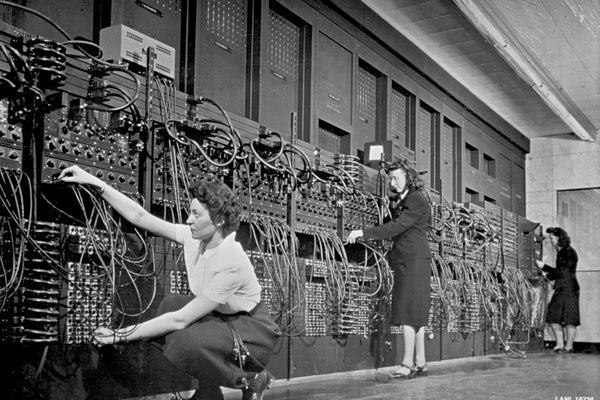Broad Band: The Untold Story of the Women Who Made the Internet
by Claire L. Evans.
Portfolio, 2018 ($27)
In the earliest days of computing, rooms of women performed manual calculations for research projects run by the national defense agencies and the precursor to NASA. Though often marginalized and outnumbered by men, women stayed in the burgeoning field of computing long after their manual number crunching was replaced by lightning-fast machines connected by global information networks. In this inspiring tale, writer Evans chronicles the contributions of some of the many women who aided the rise of the modern Internet. Memorable characters include Elizabeth “Jake” Feinler, an information scientist who helped researchers navigate the Arpanet—a forerunner to the Internet—and Stacy Horn, who started one of the first social networks, Echo. As Evans puts it, women contributed to every stage in the development of computing technology: “We're not ancillary; we're central, often hiding in plain sight.”
The Wizard and the Prophet: Two Remarkable Scientists and Their Dueling Visions to Shape Tomorrow’s World
by Charles C. Mann.
Knopf, 2018 ($28.95)
On supporting science journalism
If you're enjoying this article, consider supporting our award-winning journalism by subscribing. By purchasing a subscription you are helping to ensure the future of impactful stories about the discoveries and ideas shaping our world today.
The human population is hurtling toward 10 billion—some experts think we'll nearly hit that mark by 2050. How will the earth feed, house and otherwise support such a horde? Environmental thinkers usually fall into one of two camps: those who prioritize conservation and curbing consumption, and those who trust innovation to solve our problems. Writer Mann meticulously chronicles the lives and thought of the founders of these two philosophies. One is William Vogt, who advocated the way of caution and conservation; the other is Norman Borlaug, whose research ushered in the green revolution and who thought technology would find a way to save us.
A Lab of One’s Own: Science and Suffrage in the First World War
by Patricia Fara.
Oxford University Press, 2018 ($24.95)
In World War I many women in the U.K. replaced their aprons with chemical suits and stepped into previously male-only domains of science, where they led war research efforts. Science historian Fara illustrates the lives of many of these forgotten women. Although the era marked a major step forward for women scientists, many worked for minuscule wages in an environment of blatant discrimination. Some were belittled as “opportunists” and forced to turn over their jobs to returning male soldiers. In the nearly 100 years since, women have come a long way, Fara writes, but the glass ceilings remain solid and the pipelines leaky. —Yasemin Saplakoglu
Atom Land: A Guided Tour through the Strange (and Impossibly Small) World of Particle Physics
by Jon Butterworth.
The Experiment, 2018 ($19.95)
Butterworth, a physicist at CERN's Large Hadron Collider near Geneva, takes readers on an amusing journey through the obscure world of particle physics. Using a metaphorical map as his guide and an imaginary boat as his vessel, he sets sail through subatomic waters. The first stop is “Atom Land,” where Butterworth explains how electrons, protons and neutrons come together to build up everything we know. As the journey unfolds, we learn about lesser known particles—quarks, bosons and hadrons. We grapple with chameleon particles, supersymmetry and dark matter. Thankfully, our ship is stocked with tools such as mathematical equations and a “laser light” that illuminates the murkiest of concepts. —Y.S.

